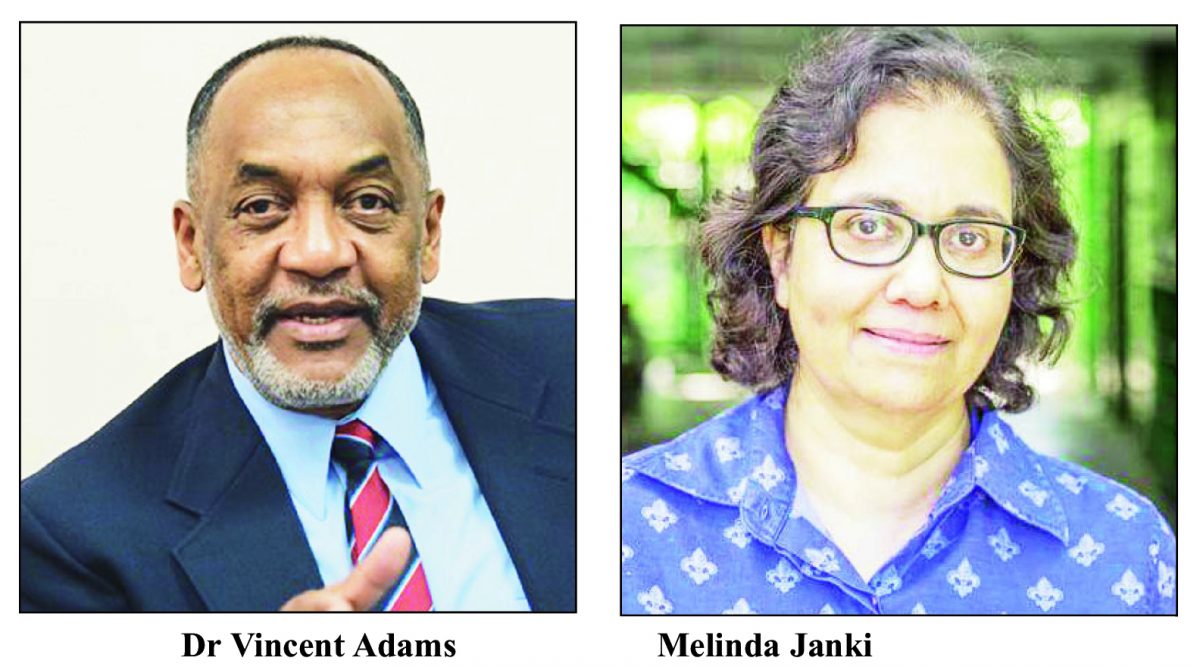Former Executive Director of the Environmental Protection Agency (EPA) Dr Vincent Adams has called out his successor Kemraj Parsram over the recent renewal of Esso Exploration and Production Guyana Limited’s permit for the Liza-1 development offshore Guyana.
Dr Adams, during a Moray House Trust panel discussion “Oil, Gas and the Environment: a review” yesterday, reminded that it was Parsram who signed the initial environmental permit for the Liza-1 development in the Stabroek Block. He also noted that there were several areas that could have been improved in both the original and modified permit.
“Mr Parsram, who is the current Executive Director, a lot of people don’t even know this is the same person who signed the Liza-1 permit. He was there two years before I arrived. So here was an opportunity for him to redeem himself really and he obviously didn’t and I probably can sympathize with him because I don’t think he has any authority [to independently function] to be honest. It is the politicians that are calling the shots at the EPA so I sympathize with the guy,” Adams said.
The Liza-1 permit was renewed on May 31, 2022, and will remain valid until May 30, 2027. This was done even as EEPGL continues to commit flaring violations owing to the failed gas compressor onboard the Liza Destiny FPSO.
The Liza-1 project was the first petroleum development to be permitted offshore Guyana and has not been without challenges. The Liza Destiny Floating, Production, Storage and Offloading (FPSO) platform has encountered major problems with its gas compression equipment resulting in environmentally-damaging gas flaring. The gas compressor failed in the middle of the night on January 27, 2021, according to Exxon.
To date, the issue has not been resolved and Exxon continues to flare above permissible levels.
Exxon has indicated that it would replace the gas compressor by the end of this year but environmentalists have been calling for the EPA to revoke the permit until the company can become compliant but those calls have fallen on deaf ears. The EPA has remained silent on the issue.
With the renewal of the permit, the EPA said that the permit strictly prohibits routine flaring and venting while specifying that flaring is only permissible during commissioning, start-up and special circumstances. It added that the permit also goes further to require the Permit Holder to pay US$50 per tonne of carbon dioxide equivalents (CO2e) emitted as a result of flaring in excess of permitted periods.
The permit also ensures that EEPGL is held liable for all costs associated with clean-up, restoration and compensation for any pollution damage which may occur as a consequence of the project.
Dr Adams, during his time at the helm of the EPA, fought with EEPGL to ensure full liability coverage from its parent companies as well as took them to court for violations. That challenge was withdrawn after Adams was removed from the EPA when the PPP/C came into government.
During yesterday’s discussion, Adams while stating that the Environmental Protection Act (EP-Act) is a strong piece of legislation that requires just minor tweaks, said both the government and the EPA continue to ignore it and give free rein to Exxon.
Petroleum engineering
“When I look at some of the changes in the EPA permit, I know for sure there is no way that anybody in the EPA understands that language to be writing it because nobody in EPA, right now, has done a single, not even a minute of training in petroleum engineering. I know the language that I am seeing in the permit, the revised language since I have left, it was written by EPA so I know that they [government and Exxon] are dictating everything else,” he said.
He added that the continued flaring is outrageous and the mere fact that it continues to be bypassed by the EPA is a major concern. He said that while Exxon is making international commitments to cut flaring by half in its operations, it continues to disregard Guyanese laws. The former EPA head further stated that the justification given by both politicians and industry officials is also “nonsense”.
Government and supporters of the oil and gas operations have been consistently pointing to Guyana’s carbon sink status as justification for its activities offshore.
Dr Adams said that Exxon can reduce its flaring if it cuts production in the Liza-1 field by only 4,000 barrels.
Referencing the issue with the gas compressor, Dr Adams said that Exxon’s exploitation of the repair clause in its permit continues without consequences by the EPA.
“So they’re [Exxon] saying as long as that piece of equipment is in disrepair, we can flare. So now, that clause, that simple clause here is allowing them to flare [an] limited amount. So you would think that it would stop there, no, but then they’ve got to cover the tracks. So they’re saying now, just to kerfuffle and confuse everybody … for the very first time we’re charging a fee for the flaring.
“It was [US]$45 but now they raise it to [US]$50, they’re [EPA] now bragging but let me tell you what that means. So every tonne of carbon dioxide flared, they paid a fine of [US]$50. I did some rough calculations because you’re not getting information, that fine and they are claiming that it is only 2% of the gas we are flaring [and] you see this is where they believe that people are ignorant. Well, 2% sounds like a really small number of anything right? They are not saying the number of barrels but 2-4% of 120,000 barrels, and I am talking about Liza 1, 4% of that is almost 5 million cubic feet of gas per day. All they’ve got to do to stop flaring is cut back production by 4,000 barrels per day because every barrel that comes up brings up 1,000 cubic feet of gas,” he explained.
Adams said that even with the US$5 increase for flaring, EPA rakes in an average of US$12,000 per day and when compared to current oil prices Exxon makes almost US$500,000 on the 4,000 barrels.
“…so Exxon is paying US$12,000 to make half a million dollars every single day. So that’s the kind of game that they play. So it’s not the deterrence, which is what the law is supposed to be, it’s an incentive,” he lamented.
On the issue of insurance, Adams reminded that he fought with EEPGL to secure liability insurance for its operations since that was not initially done.
Also on the panel was lawyer Melinda Janki who has been instrumental in the fight against environmental degradation caused by the oil and gas sector. She is one of the lawyers for three women who filed a case against the EPA to put a stop to the flaring of gas offshore by ExxonMobil, earlier this year.
“ExxonMobil started production in December 2019. In January 2020, we first began to hear from fishermen that ExxonMobil was flaring. ExxonMobil didn’t tell us to begin with. Then we heard that they were flaring billions of cubic feet of natural gas. People protested. ExxonMobil told us they had to flare because their gas compressor wasn’t working. For more than 2 years ExxonMobil has been using faulty equipment, flaring and making climate change worse and putting toxins into the air”, a release on behalf of the trio had said.
Sinikka Henry, a lecturer at the University of Guyana, Sherlina Nageer and Andriska Thorington are the litigants in the case.
Janki had also been the attorney in the case where Dr Troy Thomas secured a court order slashing the lifespan of the Liza-1 environmental permit from 20 years to five years. It was this permit which was recently renewed.
Janki used her time on the panel to highlight the shortcomings of Exxon and its consultants.
Specifically referring to its Environmental Impact Assessment for the Liza-1 Development, she said that it remains inadequate.
“So this EIA that continues in existence, it’s completely inadequate. The data that was relied on were completely inadequate,” she lamented.
She questioned the data presented and which continues to be built upon.
“Now the Liza-1 operations are located 120 miles offshore, what do you think Esso’s EIA team used for the birds’ surveys, the bird information? They used a checklist for the coast and the interior of Guyana that had been produced by the Smithsonian some 10 years earlier. Unsurprisingly, they had a problem identifying birds…they used a fish list from 1962. Now bear in mind this is being provided to the EPA in 2017,” she added.
Janki also urged persons to utilize the EP-Act and mount challenges to the decisions of both government and the EPA that are contrary to the Act.
…no show
In a press release explaining the reasoning behind the panel discussion, Moray House Trust said that the extraction of oil and gas offshore poses multiple threats to the environment and that the construction, operation and maintenance of a gas pipeline also pose significant challenges. It highlighted that for several years, Guyana has conducted a delicate balancing act between its role as an oil producer and its role as a sometimes pioneer of Low Carbon Development and now a purveyor of carbon credits.
“Maintaining equilibrium between these roles is a challenge, even for vastly more experienced O&G producers. Equilibrium hinges on many factors: a robust legal framework (to protect the environment); a network of regulatory institutions (to implement the laws and monitor operations); transparent and rigorous systems of appraisal; a wealth of data in the public domain; widespread public awareness of and trust in the foregoing. Moray House Trust has worked for a decade to promote culture and public discourse in Guyana. It was founded on the belief that culture thrives and develops where ideas circulate and are robustly debated and interrogated,” the statement added.
Both the EPA and ExxonMobil were invited to participate. Francis Carryl of the EPA was initially slated to be a part of the discussion but later pulled out. Moray House Trust also invited Exxon stating that they wanted to offer a cross-section of views. Exxon declined, citing prior commitments.
Dr Adams said that it is “regrettable and disappointing” that EPA pulled out from the discussion.
“EPA has now become the agency that is always missing in action when it comes to representation of the people. One of its core mission is to represent the citizens and taxpayers of Guyana…but like I said they’ve been missing in action,” he said.







